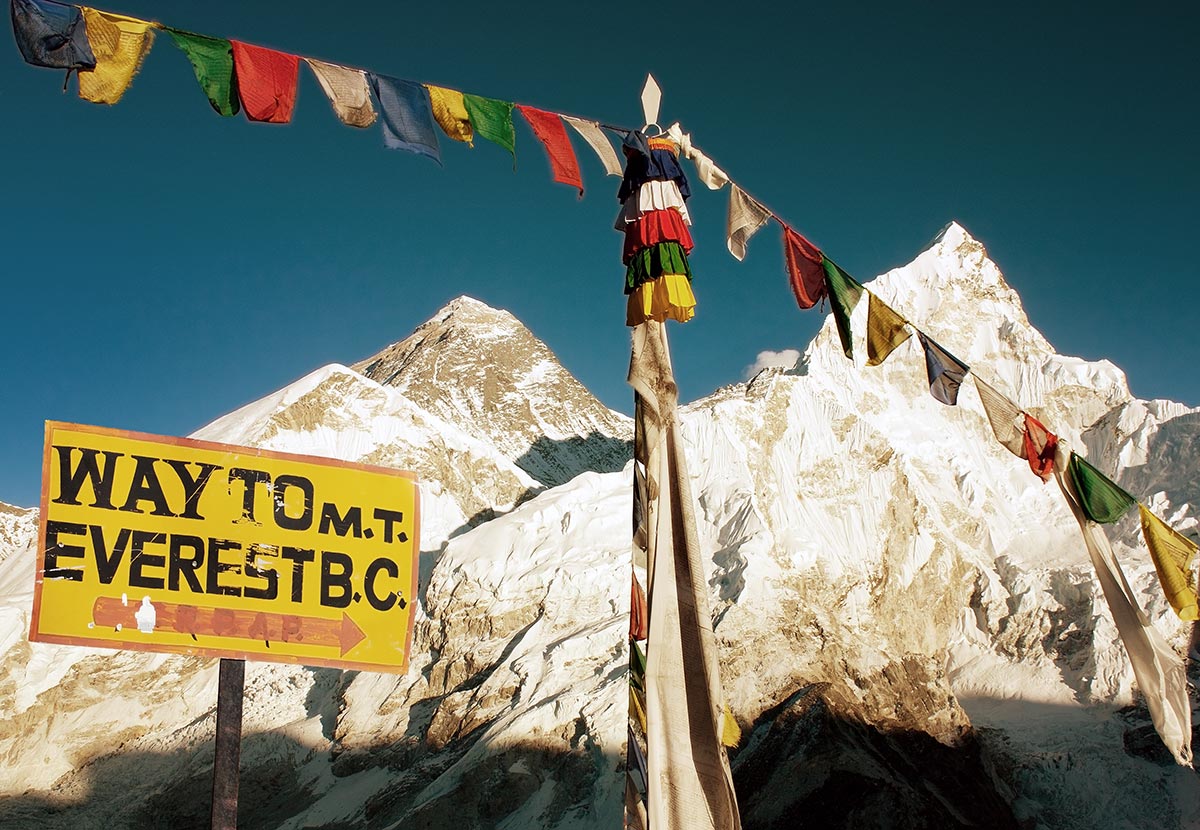Austrian climber Kurt Diemberger, the only remaining person alive to make first ascents on two 8,000 metre peaks, tells the UIAA about the historic expedition to the top of Dhaulagiri.
Diemberger will be among the guests of honour at the Dhaulagiri Golden Jubilee Celebration in Nepal in mid-May, organized by the Nepal Mountaineering Association.
Fifty years ago, a perfect day came along in the Himalaya, when the sun sparkled and the wind became a whisper, and six colleagues pushed toward the top of a rugged, dangerous peak, a “castle in the clouds”.
At 8,167 metres, Mt. Dhaulagiri was considered until the mid-1800s the world’s highest mountain. Even today it has the greatest vertical rise from the local terrain, shooting skyward for 3 kilometres. And in 1960, it remained next to last among the world’s 8,000-metre peaks to be conquered.
“It is a beautiful mountain,” said Kurt Diemberger, the Austrian climber who has stood atop peaks such as Everest and Makalu, but still holds Dhaulagiri close to his heart. “This mountain has been seen for centuries from the Indian plains, a floating white castle.”
On that day, May 13, 1960, the team reached the apex of the white castle. Now Diemberger and other mountaineers from around the world plan to gather in Nepal to celebrate the 50th anniversary of that first ascent.
The Nepal Mountaineering Association has announced it will host a Dhaulagiri Golden Jubilee Celebration in May at the International Mountain Museum in Pokhara, which lies in the Dhaulagiri region in western Nepal.
Ang Tshering Sherpa, president of the association, listed a who’s-who of mountaineering already committed to attend the event: Among them, Diemberger, who notched first ascents of both Dhaulagiri and Broad Peak; Reinhold Messner, the first to climb all 14 8,000-metre peaks; and Ang Rita Sherpa, whose 10 ascents of Everest without supplemental oxygen earned him the nickname “the Snow Leopard”.
Also planning to attend are accomplished mountaineers Peter Habeler, Chris Bonington, Ken Noguchi, Apa Sherpa and Ang Rita Sherpa.
For Nepal, Ang Tshering said, the event will celebrate the historic effort on Dhaulagiri and what it has meant since.
“The successful summiting of Dhaulagiri in 1960 holds a great importance for the development of mountain tourism of Nepal globally,” he said.
“Mt. Dhaulagiri was considered one of the deadliest mountains,” he continued. “The successful ascent on it increased mountaineering activities in Dhaulagiri area, with the uplift of economic condition of the people.”
Mountain of memories
The history of Dhaulagiri’s ascent begins long before May 13, 1960, says Diemberger.
Today, the 78-year-old Diemberger commutes between residences in Salzburg, Austria and Bologna, Italy, spending time with family and working on books about his storied mountaineering career.
Yet he remembers Dhaulagiri well. Ask about the peak and Diemberger becomes professorial, outlining years of work by many who made the ascent possible. This is what he plans to talk about, accompanied with slides, as a Guest of Honor at the Dhaulagiri Golden Jubilee. “There are so many memories,” he said.
Sixty years ago, before any human had stood atop an 8,000-metre peak, a French team reached a saddle at 5,200 metres on Dhaulagiri. Upon examining the mountain’s treacherous southeast ridge and face, the team agreed the route was “impossible” and retreated.
A month later this same French team became the first to reach the summit of an 8,000-metre peak: Annapurna. Other failed attempts throughout the 1950s followed. One of Diemberger’s favorite tales is of an expedition by the Argentinean military.
When the team reached 7,200 metres there was no place to set up camp. So it blasted the rock with dynamite to make a flat space, Diemberger said, chuckling.
The successful expedition Diemberger joined was organised by Max Eiselin of Lucerne, Switzerland. With little money for the venture, he, Eiselin and others began asking people to contribute. He said many in Switzerland, Austria, Germany and Italy sent small amounts, the equivalent of 10 or 20 Swiss francs.
Other companies donated gear. A favorite of Diemberger’s from the Dhaulagiri expedition were the reindeer knee-high boots, made in Italy from Norwegian reindeer skin. “They were very light and very good, better than some of the plastic boots today,” he said.
One fact Diemberger highlights about the Dhaulagiri expedition was its international nature. The team itself brought together people from at least five countries.
“This was an expedition which, under Swiss organisation, was the first international ascent of an 8,000-metre peak,” Diemberger said.
On the mountain
The team proceeded in spring 1960 up the mountain. The expedition employed a unique tool that also marked another mountaineering first: the use of an airplane to transport people and supplies.
The plane, called Yeti, landed and took off from a camp at 5,700 metres on the mountain. The altitude still stands today as an aeronautical record. However the Yeti crashed on May 5 as it was taking off from the camp. Nobody was injured, but it meant that the 16-member expedition was divided into three geographically isolated groups.
Diemberger was in the group that was highest on the mountain. The team built several camps at higher and higher elevations, preparing for the assault. This smaller team had more time to acclimate to the elevation, Diemberger said. The main issue in waiting for the right day, he said, was the weather.
“It was also technologically challenging, it was difficult, but the main challenge was the weather,” he said.
“Storm after storm came in.” After one failed attempt, late on May 12 it appeared the perfect day had arrived. The group made its way without oxygen, and each carrying an alpine-style load, Diemberger said.
That day, under a clear, blue sky, the team made it to the summit. In addition to Diemberger, Peter Diener, Ernst Forrer, Albin Schelbert, all Swiss, summited, as well as Nima Dorje Sherpa and Nawang Dorje Sherpa of Nepal.
Ten days later, expedition members Michel Vaucher and Hugo Weber, both Swiss, also reached Dhaulagiri’s summit.
“I am happy they also made it,” Diemberger said.
Dhaulagiri today
The route used by that first Dhaulagiri expedition remains the main one to the summit today. But other routes have since been forged on the mountain. “There will be new routes all the time,” Diemberger said.
“These were totally different times,” he continued, remembering the effort. “Now you can look down with a satellite and see this and that.”
“Whether you make it or not remains the big adventure of mountaineering. Even a satellite can’t tell you that.”
Nepal Mountaineering Association President Ang Tshering Sherpa said the Golden Jubilee celebrations of all the 8,000-metre first ascents in Nepal bring the mountaineering community together. They are also important for telling the world that things are changing in the Himalaya.
“During these celebrations, we have witnessed overwhelming support and the presence of famous mountaineers from all around the mountaineering community in the world and this has a positive impact in our country’s image,” he said. “In return, these celebrations are also an opportunity for Nepal to show deep appreciation and gratitude to the mountaineers and mountain lovers who have done so much to promote Nepal.”
Throughout the Himalayas, the ice and the glaciers are melting at an alarming rate,” he continued. “Unfortunately, Dhaulagiri is no exception to this trend.”
“We have noticed that the routes are more unstable and avalanches and rockfalls are becoming more common due to the increased temperatures. Also, the weather patterns are becoming more unpredictable and extreme.
The Nepal Mountaineering Association is very concerned about these circumstances. We are now focusing on making climbing more secure as these changes occur on the mountains by constantly improving the skills of Nepali mountaineers and their awareness of the climbing environment.”
The association is working with the Nepali government to finalise details of the Dhaulagiri celebration. Then more information will be available on the Nepal Mountaineering Association website.


